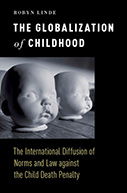THE GLOBALIZATION OF CHILDHOOD: THE INTERNATIONAL DIFFUSION OF NORMS AND LAW AGAINST THE CHILD DEATH PENALTY

Author: Robyn Linde
Publisher: New York: Oxford University Press, 2016. 328p.
Reviewer: Mary Welek Atwell | October 2017
Robyn Linde’s subject is the creation of an international definition of childhood that includes legal protections associated with age and culminates in a nearly universal opposition to imposing capital punishment on persons less than 18 years of age. The definition posits a relationship between children and the state, whereby the latter assumes responsibilities for the welfare of the young. She promises that the book will describe the process whereby age became the “single measure of childhood,” and how that process relates to the development of the modern liberal state and the international system.
There are probably hundreds of books on the death penalty. What makes this one exceptional is the focus on the abolition of capital punishment for juveniles, as an international movement. She argues that the colonial powers, Britain and France, were largely responsible for transmitting norms in opposition to the “child death penalty” to their colonies. Those norms were part of a larger process whereby the state recognized the need to provide special protections for children, sometimes against their parents and sometimes in opposition to traditional practices. As the colonial powers retreated from their domination after World War II, attitudes about the relationship between the state and children were retained in the former colonies, and were ultimately taken on by the United Nations and other human rights organizations. Those attitudes led to the first “cascade” of states abolishing the juvenile death penalty. Although I am not completely clear as to the reason why she talks of two cascades, Linde identifies periods during which nations abolished capital punishment for children. The first lasted from the 1960s until the early 1980s, the second from 1985 until 2005. One might argue that since the process involved only a two-year break between the two cascades, there was actually just one long trajectory of abolition.
As all students of the subject undoubtedly know, the United States was among the last nations (Linde calls them “laggards”) to prohibit the execution of those under 18. The U.S. began the modern era as a leader in human rights matters; but where capital punishment is concerned it stands as an outlier by maintaining the sanction when most other democratic nations have abolished it. The author devotes a significant portion of the book to explaining why the U.S. stood at the end of the abolition process, and how the Supreme Court arrived at the decision to terminate the juvenile death penalty in 2005. She is correct in attributing much of the “laggard” quality of U.S. capital punishment law to the federal system. As long as some of the states insist on retaining and using the death penalty, the United States will remain an outlier. At present, it seems quite unlikely that the death penalty will be found unconstitutional and abolished by the judiciary. Instead the Supreme Court has chipped away at the actual practice of capital punishment. When the Court has seen fit to restrict some aspect of its use, the justices cite “evolving standards of decency.” By this is meant that some element of the practice (executing the mentally disabled, executing juveniles, executing people who have not committed murder) has been rejected by a majority of states. The political process by which state laws are changed is a story in itself — and one Linde chose not to tell. If examined, however, it is likely that many organizations, including religious, academic, and child welfare groups would have been found to be involved. It may be that she exaggerates the role of international organizations and international law as factors in changing American policy regarding the juvenile death penalty.
In addition to the fairly large amount of attention to changes in American law, Linde describes the abolition of the child death penalty in Britain and France and their former colonies: Kenya, Tanganyika (now Tanzania), Algeria, and Tunisia. She also looks at Japan and Ethiopia, nations that were not colonized, but that adopted attitudes about childhood and abolition through international interactions. China and Pakistan fall into the “laggard” category as nations that have nominally rejected the juvenile death penalty, but which still use it in practice. All of this could make for an interesting story, if Linde had provided more examples that featured human actors. As it is, she reports what happened in the various countries and wedges the events into her chosen framework, which focuses on mechanisms of diffusion—the means by which attitudes about childhood were transmitted. In addition, the author spends a significant amount of time and space indicating what she is going to discuss, discussing it, and then summarizing what has just been discussed. It is not a style of writing that captivates the reader. This book apparently started out as a dissertation. It would have been much more successful if it had been substantially revised for a larger reading audience.
Mary Welek Atwell, Professor Emerita of Criminal Justice, Radford University

